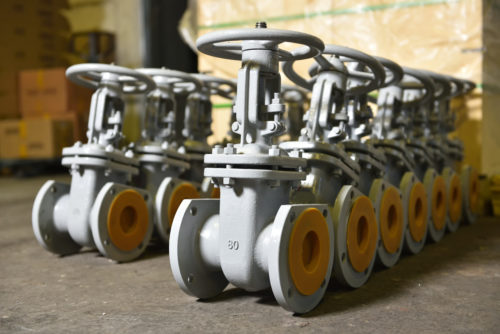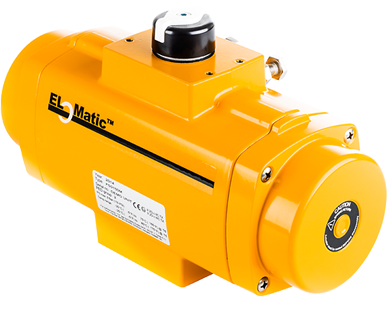Choosing the Right Valve Actuator
Leave a Comment Valve actuators are mechanical devices that allow for remote and automatic control of valves, eliminating the need for direct human involvement. Although relatively simple in design, these devices play a vital role in the overall efficiency and safety of process systems. With the significant variability in valve and actuator designs, taking the time to research and identify an actuator that fits your system’s specific requirements is critical for ensuring a smooth and successful operation. Some of these factors include:
Valve actuators are mechanical devices that allow for remote and automatic control of valves, eliminating the need for direct human involvement. Although relatively simple in design, these devices play a vital role in the overall efficiency and safety of process systems. With the significant variability in valve and actuator designs, taking the time to research and identify an actuator that fits your system’s specific requirements is critical for ensuring a smooth and successful operation. Some of these factors include:
- Valve Type: (manual, electric, pneumatic, hydraulic – must also be compatible with the power source.
- Motion Required: rotary (quarter-turn or multi-turn) or linear
- Mode of Operation: Double-acting, spring-return (spring-to-close, spring-to-open)
- Required Value Operating Thrust or Torque
- Power Supply: e.g., voltage, available air supply
- On/Off, Throttling or Proportional Control
- Corrosive Resistance: materials, coating, tubing
- Speed of Operation
- Frequency of Operation
- Special Requirements: e.g., tagging, testing
- Accessories: e.g., limit switches, positioner, solenoid, valve, transducers, manual override
Here, we discuss these several key factors and considerations that should be kept in mind during the actuator selection process.
Compatibility with Power Source
When researching valve actuator options, one of the first factors to consider is the power source. Pneumatic and electric actuators are the two most common choices for process systems. Each one has its own benefits, limitations, and requirements to consider.
- Pneumatic actuators. Pneumatic actuators, which use pressurized air or gas to create kinetic movement, require an air supply of 40-120 psi to function. However, it is important to keep in mind that higher air pressures can be difficult to achieve, while lower pressures necessitate large-diameter pistons or diaphragms to generate the desired force.
- Electric actuators. Electric actuators work by converting electricity to kinetic energy. Most require access to a 110-115 VAC power supply, although some are available with AC and DC motors of different sizes.
Given the various power requirements of actuators, it is important to select an option based on your available power source. For example, when no electricity source is available, pneumatic or hydraulic actuators are the most logical options. Frequency of operation and valve size should also be considered when determining which power source will be most effective for your actuator.
Temperature
Pneumatic actuators are generally tolerant of operating temperatures ranging from -4 to 174°F (-20 to 80°C), although specialized seals, bearings, and grease can extend this range to -40 to 250°F (-40 to 121°C). In low-temperature applications, it is important to be aware of the dew point as it relates to the actuator’s supply air. Condensate, which forms when temperatures fall below the dew point, can freeze within air supply lines and obstruct the flow of air to the actuator.
Electric actuators are capable of operating in temperatures ranging from 40-150°F (-40 to 65°C). When used in outdoor applications, it is important to properly enclose the actuator to seal it against condensation, rainwater, and forms of moisture that can damage the internal components.
Keep in mind that condensation may also enter the actuator through the power supply conduit if any moisture is present before installation. Additionally, as the motor naturally heats up and cools down during actuator operation, the resulting temperature fluctuations can create condensation. Fitting the actuator with a heater can help prevent such issues.
NEMA Guidelines
The National Electrical Manufacturer’s Association (NEMA) establishes guidelines for the manufacturing and installation of electrical equipment, including electric actuators. NEMA 7-rated enclosures can be used with electrical actuators to add explosion-proof functionality in a range of hazardous environments. Choosing an electric actuator with the NEMA 7 designation is a smart choice, especially for high-risk applications. Another option is to use pneumatic actuators, which are inherently explosion-proof due to the absence of an ignition source. Using a pneumatic actuator with electric controls is often a more cost-effective solution.
Speed
The speed at which an actuator can perform a function is directly related to power input. Increasing the speed of a task, such as the opening or closing of a valve, requires an increase in power. Fast-acting actuators are ideal when immediate isolation or opening of a system is required, and this quick action is usually provided by pneumatic, hydraulic, or solenoid actuators. In contrast, slow-acting actuators are a better option for applications that benefit from slower, more controlled actions, such as gradually injecting cold water into a hot system.
With pneumatic actuators, the desired operating speed will determine how much airflow they require. One advantage of these actuators is that their speed can be easily controlled, usually by fitting a variable orifice such as a needle valve to the air pilot’s exhaust port. While an electric actuator’s geared motor makes speed control somewhat more difficult, it can be achieved by making adjustments to the gears. In some cases, pulsing circuits can be incorporated to enable slower operation.
Frequency of Movement (Duty Cycle)
Frequency of operation is an important consideration since it influences the amount of stress and wear placed on the mechanical and control elements within the system. For example, isolation and regulating valves that require only occasional operation will experience significantly less wear than those that undergo near-constant or continuous operation. A more robust and resilient valve and actuator assembly should be selected in cases where continuous use is expected.
Expressed as a percentage, the duty cycle of an operation is the ratio of operating time to resting time. Pneumatic actuators exhibit a 100% duty cycle, making them well-suited for applications in which frequent valve operation is required. In comparison, most electric actuator motors only exhibit a 25% duty cycle, meaning they require frequent rest to avoid overheating. Duty cycle is less of a concern in automated on-off valves since they are ideal 95% or more of the time.
Size
 The following factors should be considered when determining the ideal actuator size for your application:
The following factors should be considered when determining the ideal actuator size for your application:
- Valve type and torque requirements. The actuator is sized according to the specific valve being used and its calculated torque requirements. A valve’s torque requirement refers to the quantity of force needed to open or close it.
- Minimum and maximum pressure. Pressure is another essential factor to consider when sizing an actuator for a system. It is important to test the actuator at the minimum supply pressure to make sure it can develop enough torque to function properly even at the lowest pressure point. Similarly, the valve should be able to function safely at maximum potential pressure.
- Electricity requirements. The amount of electricity required to power the actuator will depend on its size. While large actuators generally require three-phase power suppliers, single-phase supplies are sufficient for smaller actuators.
Safety
When selecting an actuator, make sure the device adheres to all relevant safety guidelines to mitigate the risk of explosions and other safety hazards. NEMA, CSA, and other regulatory bodies provide various ratings that indicate an actuator’s suitability for certain types of environments.
An additional level of safety can be achieved through the use of fail-safe actuator designs. Pneumatic spring return actuators provide fail-safe capabilities by forcing the valve into a safe position if a power or signal failure occurs. Similarly, a battery backup can act as a reliable fail-safe option for electric actuators.
Valve Actuators from Erdmann Corporation
A valve actuator has a significant influence on the performance of the valve, as well as the overall system. Selecting the right actuator helps to ensure a safer and more cost-effective operation with fewer valve replacements, less downtime, and less frequent maintenance.
At Erdmann Corporation, we take the time to understand the unique requirements and limitations of each client’s system, allowing us to provide the best possible actuator solution for the application. To learn more about our extensive actuator selection, visit our actuators page or browse our online catalog.

